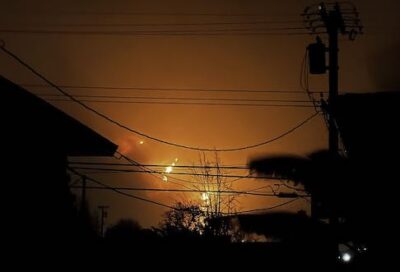Paid Intern For Social Media Campaign
You will need writing and social media skills, good phone manner and love of the subject…
You will need writing and social media skills, good phone manner and love of the subject…

The number of faults on the power grid near three of the major Los Angeles County fires skyrocketed in the hours before the blazes began, according to Whisker Labs, a company that monitors electrical activity. This new evidence is raising serious questions about the role of the electrical grid in sparking the devastating wildfires that have ravaged the region, suggesting that the grid itself, not just extreme weather, is a major culprit behind the fires.
Bob Marshall, the chief executive of Whisker Labs, spoke exclusively to The LA Times, revealing that the areas near the Eaton, Palisades, and Hurst fires all saw massive increases in faults in the hours leading up to the fires. These faults—caused by everything from tree limbs hitting power lines to wires contacting each other—create sparks that can quickly ignite dry vegetation, setting off catastrophic wildfires in a matter of minutes.
It’s a chilling reality that we have seen unfold time and again: poorly maintained power lines, combined with nature’s fury, lead to a deadly combination that fuels the flames of these modern-day infernos. And the recent findings by Whisker Labs suggest that this very scenario played out in the heart of Los Angeles County.
3 key questions that need to be answered:
Why Didn’t They Turn Off the Power?
Can Insurers Sue the Utility Companies?
Are the Executives Facing Jail Time?
The Perfect Storm of Fire and Power Lines
Let’s start with the Palisades Fire, which has already become one of the most destructive fires in the history of Los Angeles. It spread l across 17,000 acres, destroying more than 5,000 homes, and was fanned by the notorious Santa Ana winds. Winds topping 100 mph created the perfect storm, but what many don’t realize is that a crucial piece of the puzzle was the power lines.
According to Whisker Labs,by the time the fire began to spread like an uncontrollable beast, power lines were already sparking in the area. A similar pattern was observed in the days leading up to the fire, with faults in the power grid reaching dangerous levels just hours before the inferno took hold.
The pattern is clear: the power grid is malfunctioning in the worst possible way, creating a situation where something as simple as a tree branch falling on a wire can trigger a wildfire. And when the winds pick up, those sparks become an unstoppable force of nature, fueled by dry conditions and a climate increasingly prone to extremes.
In October 2017, 250 square miles burned in Northern California, destroying 6,000 homes and businesses and killing 44 people. For now, over SEVEN years later – the cause of these fires has not been determined. The private utility company Pacific Gas and Electric, known to Californians as PG&E, is under investigation. Total damage for the Northern California wildfires comes to $9 billion. PG&E has started stockpiling cash…

Over 14,000 people have signed a petition against large solar farms in their area following plans for a development covering 2,000 acres (810 hectares) in Wiltshire.
Lime Down Solar Park is designed to create 500MW of clean energy – said to be enough to power 115,000 homes – from six sites in villages in the county.
Developer Island Green Power says it will give a “net gain in biodiversity”. But locals say it will simply take away land that could be used for food growing, and provide no direct benefit to the local community.
The sites would be connected into the National Grid’s substation in Melksham, the proposals say.
The finance behind Lime Down is being provided by Macquarie Bank, an Australian company dubbed the Vampire Kangaroo — an Antipodean adaptation of the ‘vampire squid’ label applied to Goldman Sachs for the way it sucked up money — so most of the income may end up overseas.
The company has been widely accused of piling up debt at Thames Water, which it owned from 2006 to 2017, contributing to the problems at the water company.
With so many question marks over the environmental credentials of solar parks, it should be a cause for deep concern that Macquarie is involved .
The local MP, James Gray, who is against the scheme, blames ‘Wall Street hooligans’ for inflicting the Lime Down plan on his constituency and believes a British company would deal with the local community more sensitively.
He says this is not a party political issue as all the mainstream parties are fully behind Net Zero, as he is. He argues a Starmer-led government would be even more determined to push through Net Zero policies.
As locals see it, the whole political class appears to be ranged against the rural community of North Wiltshire, and their votes have nowhere to go on this issue except to fringe parties who have no hope of forming a government. So there is little political pressure on the Secretary of State to turn it down.
Many local residents are furious that big, titled landowners have been secretly in negotiation with Island Green and there are accusations of greed. On several estates, the land being offered for solar development has recently been taken back from tenant farmers. The rent being offered is a closely guarded secret, but sums in excess of £1,000 per acre per year are routinely advertised by renewables companies on the internet, perhaps five times the return that might be expected from farming.
Some farmers have been open in saying that they did not think there was a future in farming any more and this offered a lifeline. Others had been told by the developers that they would be surrounded by the solar complex whether they liked it or not, and had taken the attitude that if they couldn’t beat the development they …

Richard Stabbins begins an occasional series on the joys and heartbreaks of living on a boat in the middle of a big city.
It’s early evening on the canal towpath and I’m almost home. My hands are frozen and even getting my bike lock open had me yelping expletives. I cut a dishevelled figure on the dark stretch between Broadway Market and Victoria Park, dimly lit by LED lights of neighbouring boats. Hopping onto the bow of my floating home, crouching my way through the front door, my first thought is: “I’m so glad I’ve got a dog!”. Bruno is an excitable 30kg hound, a blessing in himself. I had stocked the stove that morning with a generous heap of coal to keep him warm. It made me love him even more. It’s been 1 degree all day and, boaters returning to a frozen tin box usually despair for an hour or more at the lack of heating that we can monitor from an app on our phone. Praise be, though – I have a hound!
That contentment does not last long. Backpack stowed away in its spot between front steps and cupboard (every boater knows, space is at the key), I set to washing last night’s dishes. I turn on the taps, hear the boiler kick in, and then that splattering sound that every boat-dweller hates to hear: the water tank is empty! I slump down on to my couch made of old pallets and recycled cushions. The serenity of a warm night with dinner and a book is replaced by the knowledge that I must cruise to the nearest waterpoint. Bruno looks on from his bed with eyes that know what’s coming. At least the batteries are full and I’ve got diesel – a (hopefully) short trip like this will use very little fuel.
First things first, I check the weather forecast on my phone. I know it’s cold, but that’s not the biggest factor – it’s the wind. Google says I’ve got two hours before wind speeds really pick up, so that’s my window to get fuel and safely find a mooring spot elsewhere. It wasn’t long ago that I had been awoken at 05:00 by a fellow boater shouting for help. Wind speeds had suddenly hit eighty-plus mph and several boats had come free from their makeshift moorings (their pegs had been dislodged as there are no mooring rings available in that part of Haggerston). One boat had swung around and was resting horizontally across the canal, blocking anything coming through. Four of usin our pyjamas fought the wind and just about managed to heave in the barge Other boats were tied up to the balcony railings of canalised flats. Ropes stretched across the towpath at neck height like deadly rubber bands – a measure taken temporarily to regain some calm and order.
That feeling of …

A new movie starring Jodie Comer explores what could happen if a flood takes the UK off-grid.
Directed by rising star Mahalia Bello the film is set in a world that sees London submerged by flood waters. Comer play a mum who tries to find her way home with her newborn child after she’s separated from her family.
The disaster movie almost happened in real life last year, when Storm Henck hit the UK. Its intense rainfall had nowhere to go except to pour into rivers, which burst their banks spectacularly across the country. More than 1,000 homes in England were flooded and some villages totally cut off, with Nottinghamshire, Shropshire, Gloucestershire and Wiltshire worst affected.
This interpretation is supported by figures from the UK Centre for Ecology and Hydrology, which last week revealed that the period between July and December in 2023 was the wettest on record for the UK. As to the reason, there is a simple explanation.
“Climate change is warming the atmosphere,” said Linda Speight of Oxford University. “A warmer atmosphere can hold more moisture so that when it rains, the rainfall is heavier and more likely to lead to flooding. In particular, we know that climate change is leading to warmer and wetter winters in the UK. We will unfortunately experience more winters like this one in the future.”
The film focuses on the love of a mother for her baby, the love between her and her partner, the love between friends and the love of community. “That’s what keeps people going and gives them strength,” said Megan Hunter, auuthr of the 2017 novel on which the film is based.
At the same time, she hopes that The End We Start From will help to raise awareness about the need to act urgently on the climate emergency facing our planet, or we too will face the end of life as we know it.
“If it becomes one of the most important things in the world to all of us, we’ll be able to make the changes we need to,” she says. “We’ve driven things this far with overconsumption, fossil fuels, capitalism: we’ve reached this point of total crisis. But this is where we are. And we need to start from here, from this end point we’ve reached, and create a new future.”
https://off-grid.net/register-renewable-cooperative
London and other cities across the UK are underprepared for the “disastrous consequences” of climate change, with issues including severe flooding and extreme heat posing a “lethal risk” to vulnerable communities, according to a new report. The London Climate Resilience Review, commissioned by mayor of London Sadiq Khan and chaired by Emma Howard Boyd, the former chair of the Environment Agency, issued a series of “urgent recommendations”, including that Whitehall should give councils more funding and powers to adapt to global warming.
The End We Start From goes on general release …

Books, articles and TV shows about beautifully-styled off-grid cabins ,continue to attract large audiences, showing our love affair with off-grid escapism continues and is even intensifying.
Off The Grid – Houses for Escape even has that escapist word in the title – and is selling well as a result. Wallpaper magazine calls it “a richly illustrated chronicle of new residential design in far-flung locations across North America.” Emphasis on “Richly.”
The “author, “Dominic Bradbury glosses over the stories of how innovative architects fleeced their clients to make everyday living in the most wild and remote locations of the United States, Europe, Asia, and Australia not only expensive, but also a self-sustaining status symbol – something to crow about in terms of energy, water, and in some cases location.
From snowbound cabins in the far Northern Hemisphere to coastal retreats that can only be accessed by boat, this fully illustrated overview explains the diverse ways in which architects are tackling extreme climates, remoteness, and sustainability challenges to enable a new way of life that is both liberating and responsible, wherever on Earth you happen to be.
It is expensive for what it is a – featuring just 42 elite and priviledged homes across the USA and the world. Contemporary projects, designed by foreign firms as well as North American architects from across the continent. Divided into three broad categories (Countryside & Forest, Waterside & Coast, and Hillside & Mountain),  The only real unifying factor is location; these are houses without access to traditional services or facilities, and are said to have a special and intense relationship with their surroundings.
The only real unifying factor is location; these are houses without access to traditional services or facilities, and are said to have a special and intense relationship with their surroundings.
Although you would be forgiven to think that many of them turn their back on the surroundings and simply serv to inflate the ego of the architects, the likes of Brillhart or Cohesion studio,, whose creation could have appeared literally anywhere in the US, but happens to be in the iconic Joshia Tree area – where passing LA journalists might choose to puff the firm up a little.…

COP 28, lost whatever remained of its credibility today, after revelations this year’s Convenor of the annual Net Zero negotiations told his audience that the target of limiting global warming to a specific target of 1.5 degrees was “not justified by the science.”
This statement, delivered at a fringe meeting on November 11th, was quite a dramatic departure from the script, and will cause huge loss of confidence in all current climate goals and affect the preparations being made by government and corporates.
CoP President A Jaber, who is also head of the UAE state oil company, is emblematic of the way regular COP meetings have been transformed into a Woodstock for green energy capitalists in genera and the oil industry in particular. There are up to 30,000 lobbyists now attending the event, plus tens of thousands of journalists politicians and civil servants. All networking and talking up their own green initiatives, perspectives and plans.
It was Cop 26 that first turned the whole show into the Green Davos. Held in November 2021 under the patronage of the UK’s Boris Johnson, who wanted it to be the perfect meeting of minds between venture capitalists, government and lobbyists, it was the first time that the oil industry lobbyist outnumbered other corporates.
And Al Jaber is correct that Prof Nordhaus, who won the Nobel Prize in 2018 for assessing the costs and benefits of action on climate change, recently concluded that the optimum target for the world to aim for is not 1.5C above pre-industrial levels, but nearer to 3C, which means there may be scope to delay the net zero target beyond 2050.
Other leading scientists on the IPCC – the United Nations own panel of climate experts, agree that the impact of climate change on the economy: “will be small relative to the impacts of other drivers. Changes in population, age, income, technology, relative prices, lifestyle, regulation, governance, and many other aspects of socio-economic development will have an impact on the supply and demand of economic goods and services that is large relative to the impact of climate change.”
There is a now a hope among the fossil fuel lobby that it may be able to seize control of the agenda. Meanwhile John Kerry, the USA’s chief climate negotiator, commenting on Al Jaber’s statement, said he was not there and could not comment on the words used, but assured listeners that the final statement would settle doubts about the continued commitment of the COP process to end fossil fuels.
…


A new generation of Lithium power stations will transform home and outdoor energy use over the next few years. When you choose a battery, the product description is full of confusing data – so how do you make your choice? Keep in mind that the number of recharges will depend on the battery capacity (expressed in ampere-hours, Ah) of the LiFePO4 battery, and the MacBook’s power consumption. A MacBook 13-inch typically has a battery capacity of around 50-60 watt-hours (Wh). This guide uses the Macbook as an example – the same would apply to any laptop with a similar power consumption and similar-sized battery.
LifePo4 Batteries are widely available and have the following advantages over other technologies –
Long Cycle Life: LiFePO4 batteries are known for their exceptional cycle life. They can typically withstand thousands of charge-discharge cycles, making them ideal for long-term off-grid use.
Deep Discharge Tolerance: LiFePO4 batteries can safely and consistently be discharged to around 80% or even lower without significantly affecting their lifespan. This means they can handle being drawn down to 5% effectively.
High Efficiency: LiFePO4 batteries have a high charge and discharge efficiency, which means you get more usable energy from them compared to some other battery chemistries.
Safety: LiFePO4 batteries are considered safer than some other lithium-ion batteries. They are less prone to thermal runaway and are less likely to catch fire, which is crucial for off-grid installations where maintenance might be less frequent.
Low Maintenance: These batteries require minimal maintenance compared to lead-acid batteries. They don’t need regular topping up with distilled water, for example.
Compact and Lightweight: LiFePO4 batteries tend to have a high energy density, allowing for a compact and lightweight design, which can be advantageous for off-grid setups.
Cost-Effective: While LiFePO4 batteries may have a higher upfront cost compared to some other battery types like lead-acid, their longer lifespan and reduced maintenance requirements often make them more cost-effective in the long run
Here are some recommended batteries with the approximate number of times each battery can recharge a 13-inch MacBook. Keep in mind that the number of recharges will depend on the battery capacity (expressed in ampere-hours, Ah) of the LiFePO4 battery and the MacBook’s power consumption. A MacBook 13-inch typically has a battery capacity of around 50-60 watt-hours (Wh).
Approximate Price: $1,000 – $1,200
Weight: Around 28-30 kg
Battery Capacity: Varies (check product specifications)
MacBook Recharges: Multiple recharges possible
Victron Energy LiFePO4 Battery:
Approximate Price: $1,200 – $1,400
Weight: Approximately 35 kg
Battery Capacity: Varies (check product specifications)
MacBook Recharges: Multiple recharges possible
Approximate Price: $900 – $1,100
Weight: Around 30 kg
Battery Capacity: 100Ah (1,200 Wh)
MacBook Recharges: Approximately 20 recharges
Renogy Smart LiFePO4 Battery: (UK)
Approximate Price: $800 – $1,000
Weight: Approximately 25 kg
Battery Capacity: Varies (check product specifications)
MacBook Recharges: Multiple recharges …

He lives in Virginia, USA, with his three dogs, on a $95,000 plot of land, that he has yet to pay for. In the past THREE WEEKS he has gone from total obscurity to No 1 in the Billboard and Itunes charts.
His song “Rich Men North of Richmond” is a howl of anger about inequality and the power of tech titans, about the wrong directions America has gone in the past few years; about the hard scabble of daily existence.
The first thing to know about Oliver Anthony is he is not interested in material success
“People in the music industry give me blank stares when I brush off 8 million dollar offers,” he told his Facebook followers. “I don’t want 6 tour buses, 15 tractor trailers and a jet. I don’t want to play stadium shows, I don’t want to be in the spotlight. I wrote the music I wrote because I was suffering with mental health and depression. These songs have connected with millions of people on such a deep level because they’re being sung by someone feeling the words in the very moment they were being sung. No editing, no agent, no bullshit. Just some idiot and his guitar. The style of music that we should have never gotten away from in the first place.”
The SECOND thing about Oliver Anthony is he understands American history.
His legal name is Christopher Anthony Lunsford. His stage name belonged to his grandfather and he says “is a dedication not only to him, but 1930’s Appalachia where he was born and raised. Dirt floors, seven kids, hard times.” In many ways those hard time have returned. Except instead of shanty towns there are people living on Venice Beach. Instead of the dustbowl there is the Fentanyl epidemic in middle America.
The THIRD thing about Oliver Anthony is he has battled mental health and addiction issues for years.
Oliver was a factory shift worker. But he had a bad fall at work and fractured his skull. It forced me to move back home to Virginia. Due to complications from the injury, it took him 6 months or so before he could work again.
From 2014 until just a few days ago, he worked outside sales in the industrial manufacturing world, getting to know tens of thousands of other blue collar workers on job sites and in factories.
“Ive spent all day, everyday, for the last 10 years hearing the same story,” he says. “People are SO damn tired of being neglected, divided and manipulated.”
In 2019, he paid $97,500 for the property where he lives near Farmville, VA, and he still owes about $60,000 on it. He is living in a 27′ camper with a tarp on the roof that he got off of craigslist for $750. You can see the land in our video here.
“There’s nothing special about …

Lord Deben, may have stepped down as head of the UK government committee on climate change (CCC), but the Brits have not heard the last of his pronouncements on the environment. The former Tory Cabinet Minister is emerging as a radical critic of the UK energy industry in general, and large-scale nuclear in particular.
In his first formal action since leaving the CCC, Deben has joined the likes of Swampy, and former Extinction rebellion spokesmen Rupert Read and Julian Thompson, in supporting the Climate Majority Project (CMP).
The new group has the same line on the climate emergency as Extinction Rebellion and Just Stop Oil – but does not follow the same tactics.
“The whole idea is a very good one,” he tells me in a phone call. “You put together all those people who don’t want to hold up the traffic but do put climate change first. If it veers off the straight and narrow I will say so publicly.”
Rather than blockading the streets, the CMP calls on individuals to do the “many smaller things” needed to reduce pollution and carbon emissions. That, says Lord Deben, includes contacting your MP.
In a speech to eco-activists at the Glastonbury Festival last month he demanded to know who of the 200 audience had contacted their own MP about climate change within the previous 6 months. “Out of the whole lot there were only three. Its no good moaning about these things. You must make sure that all MPs of all parties cannot go to their surgeries without hearing a clear view of what can be done. We can all do that. You cannot ask government to do things unless you have done all the things you can do yourself.”
He cites Rachel Carson’s Silent Spring, her seminal 1962 book on the dangers of pollution, as a major influence on his leadership on the environment. He is also a religious man, a Catholic who sees his faith as tightly woven with his social calling.
On the day we spoke, the former Conservative Cabinet Minister was reacting to media stories commenting on the Uxbridge by-election. A narrow Tory victory over Labour was taken as evidence the public were not behind Net Zero policies like the London-wide ban on older vehicles .
“We are in a dangerous moment. In The Times today, for example, it says ‘don’t lets frighten people about climate change’ – but you know that behind that is a desire to avoid doing anything too difficult.”
Meanwhile the first Green council in rural UK was recently elected near Deben’s farm in North Suffolk. But “it has just said its minded to turn down a planning application for a new solar farm. It was almost the first decision they made!”
From his vantage point of 10 years at the helm of the CCC, Deben is probably the best-informed green …

People are talking about and demanding “Climate Justice.” But what does the term actually mean, and how do we get it?
Inequalities of energy consumption, and other resources like water and food are the biggest causes of climate injustice. Energy is responsible for 75% of all carbon emissions, and therefore is the highest priority.
The main debate around climate justice is about disparities involved in tackling climate change. Rich countries can adapt in ways that poor countries cannot, and rich people can adapt in ways poor people cannot – turning up the aircon during hot weather, for example.
Going off-grid and switching to renewables is the biggest step that wealthy economies can take – because it leads to the sharpest reductions in energy consumption.
As we all begin to adapt to the new climate reality – here are some ways to a just transition:
Do what you can. Collaborate, don’t compete. Support communities that are already disproportionately impacted (communities of color, rural communities and communities of lower economic status). Let them lead the way. They already are.
We can all do something, but we have to talk about it first.
…

Miles from anywhere, your battery powered devices are a lifeline – especially your phone. Apple, Samsung and most other device manufacturers say to avoid letting the temperature of your battery-powered gadgets dip below 32 degrees Fahrenheit or rise above 95 degrees. So make sure you don’t let them freeze overnight. Or get too hot.
Here are some other dos and don’ts for taking care of your precious smartphones.
DON’T: Burn out your battery
You might be abusing your battery, especially if you have a habit of leaving the screen on, shutting down apps or tossing it in your bag on a particularly frigid morning.
Smartphones are designed to keep apps open in the background. Forcibly closing them may satisfy that little part of your brain that wants to keep things neat and tidy, but because it takes more juice to start an app fresh than to wake it up, you’re beating up on your battery every time you do it.
In either case, damage can occur, lowering – in some cases, dramatically – the life of your battery.
Never leave your laptop or mobile device in a hot car or attempt a sub-zero bike ride with your smartphone strapped to the handlebars. If it’s particularly cold outside, keep your phone in a pocket, so it can benefit from the warmth of your body, and conversely, keep electronics out of direct sunlight for extended periods of time.
2. DO: Charge early and often
Stop with the “all or nothing” thinking when it comes to your smartphone battery. Charging your phone to 100% may seem like a good idea, but if you’re using a high-voltage charger, it can put a strain on your battery. Instead, he said to pull the plug at 80%-90% for optimal usage. Old nickel-based batteries had a memory effect, which meant that if you didn’t charge them from 1-100%, they started to ‘forget’ their maximum capacity. As for the modern-day lithium batteries, the most stress is put on the battery when charging or discharging them fully; both reduce the charging cycles and overall battery life cycle.
Do “more fast top-ups during the day,” versus charging smartphones overnight. Once batteries reach 100%, they will start doing trickle charges, which means that the phone will allow the charge to drop down a little and then recharge to 100%.
Try to keep the battery above 30% or so, letting it discharge occasionally to calibrate the sensors, and you’ll keep your battery healthier longer.
Even the most battery-conscious among us find our phones totally drained from time to time. If you’re on the grid home it’s not a big deal, but what if you’re stuck in an airport terminal or in the desert? To get the absolute fastest charge, toggle on Airplane Mode after plugging it in. Doing so will cut off data connections and should prevent virtually all notifications …